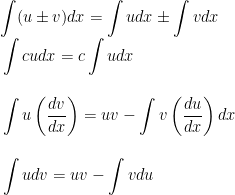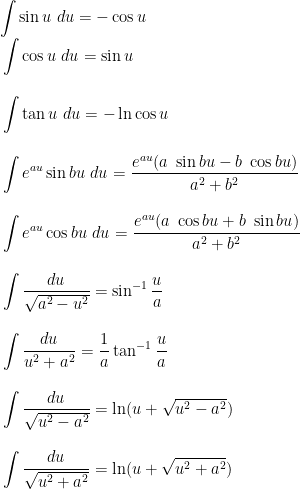The ideas of previous article can be extended to the case where the un are functions of x denoted by un(x). In such case the sequences or series will converge of diverge according to the particular value of x. The set of values of x for which a sequence or series converges is called the region of convergence, denoted
.
The series u1(x) + u2(x) + … converges to the sum S(x) in a region
if given ε > 0 there exists a number N, which in general depends on both ε and x, such that |S(x) – Sn(x)| < ε whenever n > N where Sn(x) = u1(x) + … + un(x). If you can find N depending only on ε and not on x, the series converges uniformly to S(x) in
. Uniformly convergent series have many important advantages as indicated in the following theorems.
- If un(x), n = 1, 2, 3, … are continuous in a ≤ x ≤ b and ∑ un(x) is uniformly convergent to S(x) in a ≤ x ≤ b, then S(x) is continuous in a ≤ x ≤ b.
- If ∑u(x) converges uniformly to S(x) in a ≤ x ≤ b and un(x), n = 1, 2, 3, … are integrable in a ≤ x ≤ b, then
- If un(x), n = 1, 2, 3, … are continuous and have continuous derivatives in a ≤ x ≤ b and if ∑un(x) converges to S(x) while ∑u’n(x) is uniformly convergent in a ≤ x ≤ b, then
- If there is aset of positive constants Mn, n = 1, 2, 3, … such that |un| ≤ Mn in
and ∑Mn converges, then ∑un(x) is uniformly convergent [and also absolutely convergent] in
.
An important test for uniform convergence, often called the Weierstrass M test, is given by the above.
月: 2013年12月
一様収束
前回の記事で述べた考えは un が x の関数の場合,un(x) と記述するが,に拡張できます.そのような場合,数列または級数が収束するか発散するかは x の特定の値に依存します.数列や級数が収束する x の値の集合は収束領域と呼ばれ, と表記します.
級数 u1(x) + u2(x) + … は領域 内の S(x) の合計に収束します,もし ε > 0 があってε と x の両者に依存するある数 N があり,|S(x) – Sn(x)| < ε を満たし,常に n > N であって Sn(x) = u1(x) + … + un(x) の場合には.もし ε のみに依存し,x には依存しない N を見つけられるなら,その級数は
内の S(x) に一様収束します.一様収束級数には次の定理に示すように多くの利点があります.
- 仮に un(x), n = 1, 2, 3, … が a ≤ x ≤ b の範囲で連続であり,かつ ∑ un(x) が a ≤ x ≤ b の範囲で S(x) に一様収束するなら S(x) は a ≤ x ≤ b の範囲で連続である.
- 仮に ∑u(x) が S(x) に a ≤ x ≤ b の範囲で一様収束し,かつ un(x), n = 1, 2, 3, … が a ≤ x ≤ b の範囲で積分可能である場合は以下が成り立つ.
- 仮に un(x), n = 1, 2, 3, … が連続でかつ a ≤ x ≤ b の範囲で連続して微分可能であり,さらに ∑un(x) が S(x) に収束し,∑u’n(x) が a ≤ x ≤ b の範囲で一様収束するなら以下が成り立つ.
- 正の定数 Mn が存在し n = 1, 2, 3, … で
領域内の Mn において |un| ≤ Mn であり,かつ ∑Mn が収束する場合,故に ∑un(x) は
に一様収束する.
一様収束の重要な判定法があり,しばしば Weierstrass M test と呼ばれますが,上記に示したとおりです.
Sequences and series
A sequence, indicated by u1, u2, …or brief by
, is a function defined on the set of natural numbers. The sequence is said to have the limit l or to converge to l, if given any ε > 0 there exists a number N > 0 such that |un – l| < ε for all n > N, and in such case it is described
. If the sequence does not converge, it’s called that it diverges.
Consider the sequence u1, u1 + u2, u1 + u2 + u3, … or S1, S2, S3, … where Sn = u1 + u2 + … + un. It’s called
the sequence of partial sums of the sequence
. The symbol
or
or briefly
is defined as synonymous with
and is called an infinite series. This series will converge or diverge according as
converges or diverges. If it converges to S it’s called S as the sum of the series.
The following are some important theorems concerning infinite series.
- The series
converges if p > 1 and diverges if p ≤ 1.
- If ∑|un| converges and |vn| ≤ |un|, then ∑|vn| converges.
- If ∑|un| converges, then ∑un converges.
- If ∑|un| diverges and vn ≥ |un|, then ∑vn diverges.
- The series ∑|un|, where |un| = f(n) ≥ 0, converges or diverges according as
exists or does not exist. This theorem is often called the integral test.
- The series ∑|un| diverges if
. However, if
the series may or may not converge.
- Suppose that
. Then the series ∑un converges (absolutely) if r < 1 and diverges if r > 1. If r = 1, no conclusion can be drawn. This theorem is often referred to as the ratio test.
数列と級数
数列は自然数の集合に基いて定義される関数であり,次のように示されます.u1, u2, … 略記すると となります.任意の ε > 0 があり,ある数 N > 0 が存在し,|un – l| < ε が全ての n > N について成り立つ時,この数列は極限値 l を持つ,または l に収束するといいます.そのような場合には
のように記述します.数列が収束しない場合は発散するといいます.
次のような数列を考えてみます. u1, u1 + u2, u1 + u2 + u3, … または S1, S2, S3, … ただし Sn = u1 + u2 + … + un.これを と記述し,数列
の部分和の数列と呼びます.その記号は
または
または略記して
のように定義し, と同義であり無限級数と呼びます.この級数が収束するか発散するかは
が収束するか発散するかに依存します.S に収束するなら S は数列の合計と呼びます.
以下は無限級数についてのいくつかの重要な定理です.
- 級数
は p > 1 なら収束し, p ≤ 1 なら発散する.
- ∑|un| が収束しかつ |vn| ≤ |un| なら ∑|vn| は収束する.
- ∑|un| が収束するなら ∑un は収束する.
- ∑|un| が発散しかつ vn ≥ |un| なら ∑vn は発散する.
- 級数 ∑|un| ただし |un| = f(n) ≥ 0 が収束するか発散するかは
が存在するかしないかに依存する.この定理はしばしば積分判定法と呼ばれる.
- 級数 ∑|un| は
なら発散する.しかしながら,仮に
の場合,級数が収束するか発散するかは分からない.
- 次のように仮定してみる.
. すると級数 ∑un converges (absolutely) は r < 1 なら収束し, r > 1 なら発散する.r = 1 の場合結論は一定ではない.この定理はしばしば比判定法として引用される.
Special types of functions
Polynomials
Polynomial is formula as below;

If
, n is called as degree of polynomials.

where the binomial coefficients are given by
and where factorial n, i.e. n! = n(n -1)(n-2)…1 while 0! = 1 by definition.Exponential function

An important special case occurs where a = e = 2.718…
Exponential law
Logarithmic function

These functions are inverse of the exponential functions, i.e. if ax = y then x = logay where a is called the base of the logarithm. If a = e, which is often called the natural base of logarithm, it’s described loge by ln x, called the natural logarithm of x.
Logarithmic law
特殊な関数
多項式
多項式は下記のように表現します.
の時, n は多項式の次数といいます.
二項係数は下記のように表現します.
n の階乗は n! = n(n -1)(n-2)…1 であり,定義上 0! = 1 となります.
指数関数
a = e = 2.718… の時,特殊な例が発生します.
指数法則
対数関数
対数関数は指数関数の逆関数です.仮に ax = y である時,逆関数は x = logay であり a は対数の底と呼びます.a = e の時,それを自然対数の底と呼び,x の自然対数 logex のことを ln x と表現します.
対数法則
Integrals
Integrals
If dy/dx = f(x), then it’s called that y an indefinite integral of f(x) and denoted as

If
, then

Integral formulas
In the following u, v represent functions of x while a, b, c, p represent constants.

This is called integration by parts.

where w = u(x) and w’ = dw/dx expressed as a function of w. This is called integration by substitution or tranformation.


積分
積分
ある関数について dy/dx = f(x) である時,y は次のように表現されます.
の時,積分は以下のように定義されます.
積分公式
関数 u, v および定数 a, b, c, p について下記が成り立ちます.
Derivatives
Derivatives
The derivative of y = f(x) at a point x is defined as

where h = Δx, Δy = f(x + h) – f(x) = f(x + Δx) – f(x) provided the limit exists.
Differentiation formulas
In the following u, v represent function of x while a, c, p represent constants. It’s assumed that the derivatives of u and v exist, i.e. u and v are differentiable.

In the special case where u = x, the above formulas are simplified since in such case du/dx = 1.
微分
微分
関数 y = f(x) のある点での微分係数は下記で定義されます.
微分公式
u, v が x の関数であり a, c, p が定数を示す時,以下の微分公式が成り立ちます.
Rules of algebra
If a, b, c are any real numbers, the following rules of algebra hold.
- Commutative law for addition
- Associative law for addition
- Commutative law for multiplication
- Associative law for multiplication
- Distributive law
Commutative law for addition

Associative law for addition

Commutative law for multiplication

Associative law for multiplication

Distributive law

代数における交換法則,結合法則,分配法則
a, b, c が実数の時,下記の法則が成り立ちます.
- 和の交換法則
- 和の結合法則
- 積の交換法則
- 積の結合法則
- 分配法則

